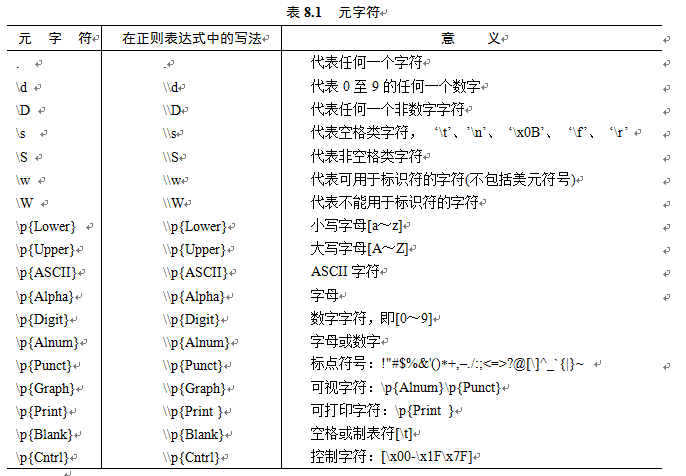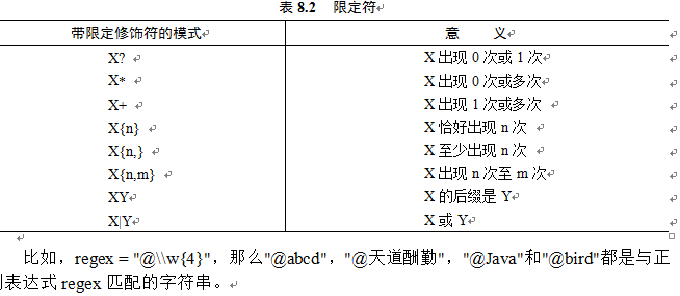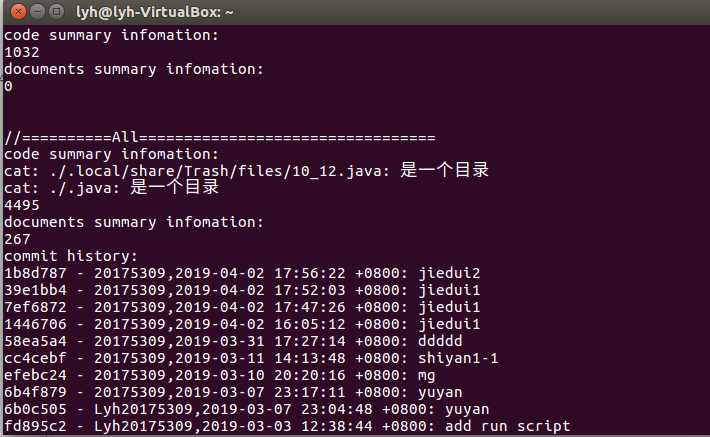教材学习内容总结
第八章 常用实用类
String类
1.String类不可以有子类。
2.用户无法输出String对象的引用,输出的是字符序列
3.构造方法:String s = new String("We are students");
4.其他构造方法:String (char a[ ]) 和 String(char a[],int startIndex,int count)
字符串的并置
1.String对象可以用“+”进行并置运算,即首尾相接得到一个新的String对象。
String类的常用方法
1.获取一个String对象的字符序列的长度:public int length()
2.比较当前String对象的字符序列是否与参数s指定的String对象的字符序列相同:public boolean equals(String s)
3.判断当前String对象的字符序列前缀和后缀是否是参数指定的String对象s的字符序列。
public boolean startsWith(String s) //前缀
public boolean endsWith(String s) //后缀
4.按字典序与参数指定的String对象s的字符序列比较大小:public int compareTo(String s)
5.判断当前String对象的字符序列是否包含参数s的字符序列:public boolean contains
6.public int indexOf (String s)和public int lastIndexOf(String s)
7.public String substring(int startpoint) 8.public String trim`
字符串与基本数据的相互转化
1.将字符序列转换为int型:x = Integer.parseInt(s); 类似的byte、short、long等等一样。 2.将数值转化为String对象:String str = String.valueOf(int/byte/long/float/double n)`
对象的字符串表示
一个对象调用public String toString()方法返回的String对象的字符序列的一般形式为:
创建对象的类的名字@对象的引用的字符串表示
字符串与字符、字节数组
1.字符串与字符数组的方法:getChars//复制到参数c指定的数组中和public char[] toCharArray()
2.字符串与字节数组的方法:
String(byte[],int offset,int length)
public byte[] getBytes()
public byte[] getBytes(String charsetName)
3.字符串的加密算法:P186
正则表达式及字符串的替换与分解
1.正则表达式
元字符

限定符

2.字符串的替换
String对象调用public String replaceAll(String regex,String replacement)方法返回一个新的String对象
3.字符序列的分解
使用public String[] split(String regex)方法
StringTokenizer类
分解字符序列,构造方法为:
StringTokenizer(String s)
StringTokenizer(String s, String delim)
Scanner类
方法:1.next()方法用来一次返回被解析的字符序列中的单词
2.如果含有数字可以用nextInt()和nextDouble()来代替next()方法。
StringBuffer类
1、length():获取实体中存放的字符序列的长度。
2、capacity():获取当前实体的实际容量。
3、StringBuffer append(String s):将String对象s的字符序列追加到当前StringBuffer对象的字符序列中,并返回当前StringBuffer对象的引用。
4、public char charAt(int n)和public void setCharAt(int n,char ch):得到序列位置n上的字符和替换ch指定的字符。
5、StringBuffer insert(int index,String str):将参数str指定的字符序列插入到参数index指定的位置。
6、public StringBuffer reverse():将对象实体中的字符序列翻转。
7、StringBuffer delete(int startIndex,int endIndex):从当前StringBuffer对象的字符序列中删除一个子字符序列,并返回当前对象的引用。
8、StringBuffer replace(int startIndex,int endIndex,String str):将当前StringBuffer对象的字符序列的一个子字符序列用参数str指定的字符序列替换。
Date类与Calendar类
1.使用无参数构造方法:Date()
2.使用带参数的构造方法:Date(long time)
3.使用Calendar类的static方法getInstance()可以初始化一个日历对象:Calendar calendar = Calendar.getInstance()
4.calendar对象可以调用方法:
public final void set(int year,int month,int date)
public final void set(int year,int month,int date,int hour,int minute)
public final void set(int year,int month,int date,int hour,int minute,int second)
5.calendar对象调用public long getTimeInMillis()可以返回当前calendar对象中时间的毫秒计时。
日期的格式化
format方法:format(格式化模式,日期列表)
format(Locale locale,格式化模式,日期列表);
Math类
Math类的常用类方法:
public static long abs(double a)\ 返回a的绝对值。
public static double max(double a,double b) \返回a、b的最大值。
public static double min(double a,double b) \返回a、b的最小值。
BigInteger类
BigInteger类的常用类方法:
public BigInteger add(BigInteger val)\ 返回当前对象与val的和。
public BigInteger subtract(BigInteger val) \返回当前对象与val的差。
public BigInteger multiply(BigInteger val) \返回当前对象与val的积。
Random类
public Random();
public Random(long seed);
数字格式化
1.可使用String类调用format方法对数字进行格式化。
2.格式化整数
3.格式化浮点数
Class类
方法:
public static Class forName(String className) throws ClassNotFoundException
Console类
Console cons = System.console();
char[] passwd = cons.readPassword();
Pattern类与Matcher类
1.使用正则表达式regex作参数得到一个称为模式的Pattern类的实例pattern:Pattern pattern=Pattern.compile(regex)
2.得到可以检索String对象input的Matcher类的实例matcher:Matcher matcher=pattern.matcher(input);
代码托管

学习心得
第一次的实验我抽到了凯撒密码就已经用到了String类,这方便了我这周的学习,也使我几乎没有遇到问题,最近实验越来越多,学习java的时间也越来越少,希望自己可以不忘初心,继续前进。